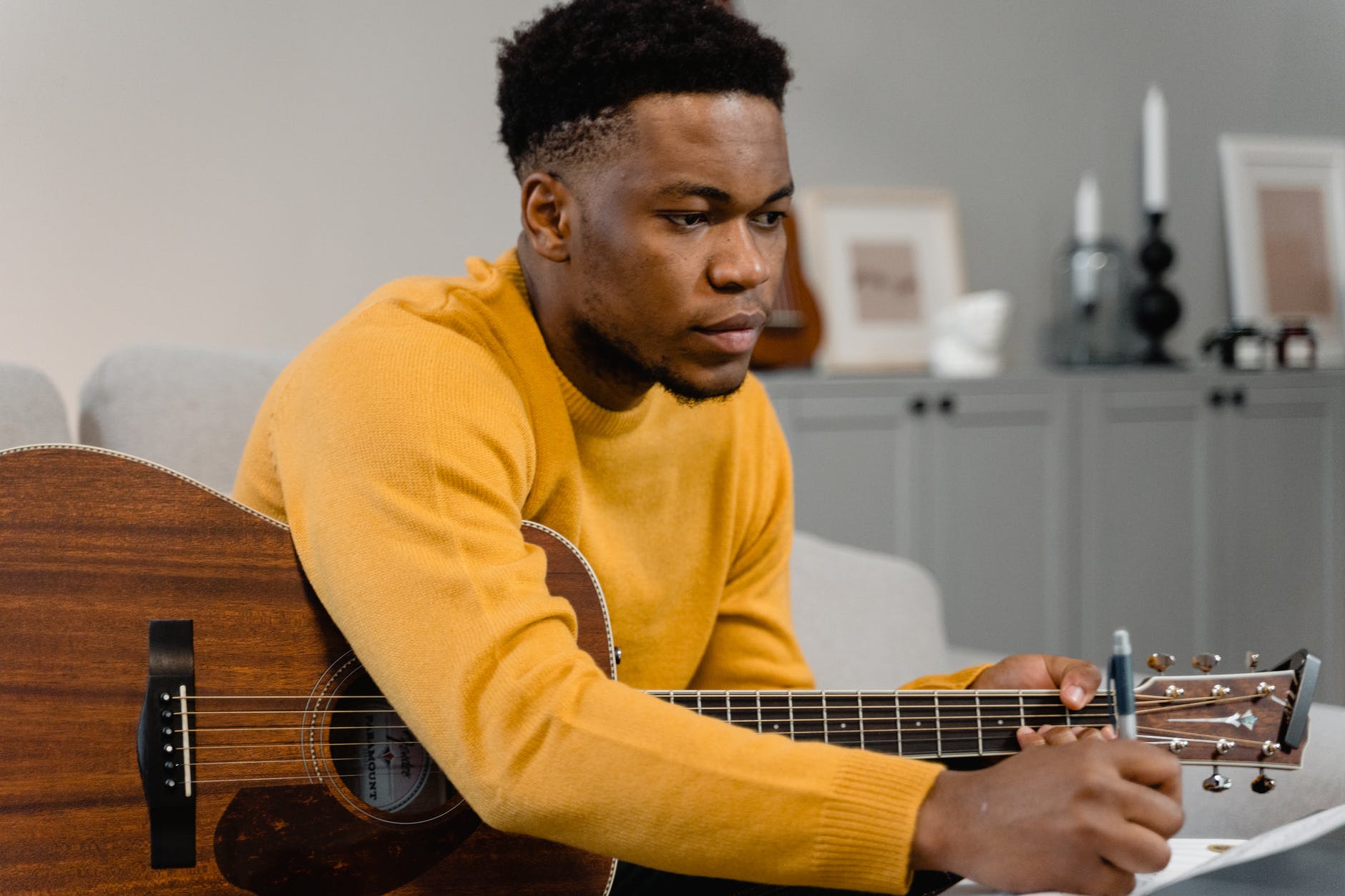Listening to music is part of everyday life. Music listening for humans is not a recent behavior. Musical activities appear to have been a piece of human history for 250,000 years or more. Music can take us to another moment in time or place in the world simply by listening to it. It can change our mood, improve our self-awareness, lead us to overcome hardships. It gives us an opportunity for social interaction and relationship building. Many cultures believe and say that music helps humans heal.
If you spend a lot of time at home and you are interested to learn something new, learning to play a musical instrument at home may be the perfect new hobby for you. The same for your children this can be a great thing for the entire family.
Why should you learn to play a musical instrument?

Aside from the obvious benefits of filling your home with the sounds of live music played by you, learning to play an instrument offers many other benefits for your mind, body, and soul.
Playing music is fun. Learning it can be fun. Practicing your instrument each day is a great way to combat boredom. You enjoy practicing on your own. When you can pick up an instrument and join in on a jam session, your social life is bound to improve. Even in the time of digital socializing, there are many opportunities to meet and collaborate with others who are learning the same instrument or want to join together and make music for fun. Another fun way is to stay creatively inspired. You can even experiment with using a melody generator and create your own tunes.
Studying music can make you smarter. Research tells us that learning to play a musical instrument enhances verbal memory, spatial reasoning, and literacy skills. When you are enjoying the process of playing a musical instrument you are actually using both sides of your brain at the same time. This strengthens the brain’s ability to operate at peak performance. That is why it is a great reason for children or teens to learn an instrument like the piano.
Playing music makes you more creative. If you are a creative person or would like to tap into your creativity a little more, picking up a musical instrument may be just what you need to get the artistic juices flowing. Putting your whole body and soul into the act of playing your musical instrument may unlock new levels of thought and emotion.
How can playing music impact your lifestyle?

There is no doubt that life is better with more creativity, fun, and brainpower — and you get all of that when you learn to play a musical instrument. But what else can learning to play music do for your life?
Playing an instrument relieves stress. Simply playing your favorite song to yourself or someone you care about can help you relax. Your breathing slows down and becomes more regular, your focus and attention are shifted to the present moment, your posture changes, and you can even lower your heart rate and stress hormones through the act of playing an instrument.
Learning to play a musical instrument provides a sense of achievement and confidence. Think about it: When you’re practicing something over and over again and begin to master something you once thought was very hard, you can’t help but feel a sense of accomplishment. And if you can do that one thing, maybe you can do anything — including writing and performing your own, original songs.
Practicing a musical instrument improves patience and memory. How could it not? Practicing the same song over and over again takes a lot of patience. Learning how to play the song and go through the movements over and over again requires you to memorize the movements, which improves your memory. The patience you exhibit in learning a new song may even spill over into the rest of your life, making your memory and patience better in all areas.
Learning a new instrument increases self-discipline and time management skills. When you’re accountable for your musical practice all by yourself, you’re showing yourself that you are capable of managing your time and demonstrating self-discipline. Time management and self-discipline skills are very helpful to everyone, especially if you are someone who works alone or from home.
Playing music is physical activity. The physical benefits of playing music include stress relief, but you’re also moving your body — especially if you’re playing a demanding instrument or like to dance or stand up while you play. Depending on the instrument, you could be working through some rigorous activity and even some cardio.
Which musical instruments are the easiest to learn to play by yourself?

Now that you’ve decided you’re going to become a self-taught musician, you’ll need to decide which instrument is best for you. In addition to your preferences for sound and style, you’ll need to consider your budget, the amount of space you have, and your proximity to neighbors.
Here are some common instruments to learn and play by yourself:
Keyboard. A keyboard is a good option if you have limited space and are just starting out with learning to play music. A keyboard usually provides a variety of sound options, making it a fun choice for children to learn on. A keyboard is portable, and you can change the volume or play while wearing headphones, making this an ideal option for people in apartments or sharing spaces with others. Once you master the keyboard, you’ll be able to play the piano with ease.
Piano. This classic and versatile instrument is considered both a stringed and a percussion instrument. With 36 black and 52 white keys, playing the piano can be a physical workout as well as a mental exercise. A piano takes up space in your home and is not very portable — you’ll probably need to hire a special moving company to move your piano if you change locations.
A piano is actually a very accessible instrument and there are portable pianos and digital pianos that are both compact, easily stored away, and ideal for smaller spaces. They can also be played silently through headphones…You can even get silent acoustic pianos!
Guitar. The guitar is a string instrument that can have between four and eighteen strings. A regular guitar has six strings, and when you pluck them, the sound is projected from the body of an acoustic guitar or through an amplifier in an electric guitar. Learning the guitar is a handy social skill to have since many people can enjoy this instrument and like to sing or play along with it. Guitars are easily portable, and learning to play the guitar improves your basic understanding of music theory. The guitar is a great choice for someone who is very interested in using music as a way to connect with others. Keep in mind that there are great guitar learning apps; given the current circumstances it might be difficult to step outside the home to take music lessons, but thanks to technology there are other options available in the digital realm.
Ukulele. A ukulele is a highly portable instrument since it’s so small. It also has just four strings, so it’s not very difficult to learn. Ukuleles are also great for songwriting, and you can learn to play it classic Hawaiian style or more along the lines of indie rock style. Ukuleles are inexpensive and fun to play.
Recorder. A recorder is a wind instrument and a great first instrument to begin learning music on. Many children in school learn to play this instrument as their first because it’s portable, easy to learn, and inexpensive. Using only your breath, tongue, and hand-eye coordination, learning to play the recorder is a great way to begin your journey to being a self-taught musician.
Percussions or drums. Learning to play the drums is fun, and there are many types of drums that produce many different sounds, for example, electronic drums. Drums are usually constructed from a hollow body or shell, with a membrane stretched across the top to create the drumming surface. You can play the drums with your bare hands, such as the bongos, or you can use sticks wire brushes on a drum kit to create a variety of sounds and rhythms. In a band, the drums keep the timing in a song. Drum circles, where everyone is playing the drums, can be very fun and even healing.
Saxophone. The soul of the blues. The saxophone is an air instrument that will require a lot of lung function, which means that it’s also an excellent way to keep your lungs healthy.
The saxophone can many times be overlooked as an instrument you can learn from the comfort of your home, and the best part is that you don’t need to sign while playing it!
Learning a New Musical Instrument from Home – How to Get Started

If you’re a brand-new music student, spend some time researching the type of lessons you want to take. Lessons are fairly inexpensive, especially if you learn in a class rather than one-on-one with a teacher. You can also find classes online, both free and paid, as well as great music learning apps.
Find a place in your home where you’ll practice your instrument. This can be a dedicated room, a corner of the living room or basement, or your bedroom. When you’re setting up your practice space, keep these things in mind:
Lighting is important. You’ll need to be able to see what your hands are doing while you’re learning to play an instrument, so choose a place in your home that’s well-lit or near a window — but not so bright that you’re squinting to see
Make it comfortable. Make sure you have a comfortable place to sit or stand, depending on your instrument. You should have everything you need to sustain your practice time, such as your music sheets or computer, your cell phone for recording, water to keep yourself hydrated — especially if you’re singing along with your playing.
Make sure there’s room for other musicians if you’re thinking about having jam sessions or starting a band. If you’re working with a live class or teacher, create a scene with good lighting, an uncluttered background, and an appropriate camera angle for your face. It will set the tone for a less distracting and more focused practice time.
Set goals, and follow-through. By going slowly and pacing yourself with goals from week to week, you’ll be more likely to enjoy the experience of learning. Be patient, realistic, and persistent. Don’t give up when the going gets rough!
Choose music and songs you love. Choosing a song to learn that you can’t get enough of is a good idea because chances are, you’ll need to play it over and over again before you master it. Find music you love to hear, and you’ll find it incredibly rewarding when you can play it for yourself.
Study music theory. Although you don’t need to understand music theory to play an instrument, learning music theory helps you learn faster and more thoroughly. People who understand music theory are better able to quickly learn multiple musical instruments.
Find ways to stay motivated. It’s easy to stay motivated when you’re learning a new instrument because the payoff is so wonderful. Stay inspired by using musical training videos, online lessons, apps, or simply practicing with a friend. A virtual or in-person jam session is a fun way to spend an evening with your friends.
Whether you want to become a performing musician or you’re simply looking for a creative hobby to enrich your mind and spirit, learning how to play a musical instrument is something fun to do at home in your spare time. With some time, patience, and practice, you can become a self-taught musician from the comfort of your own home.




